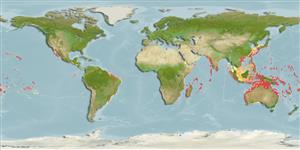Common names from other countries
Environment: milieu / climate zone / depth range / distribution range
Ecologie
; diepteverspreiding 0 - 82 m (Ref. 89006). Tropical
Atlantic, Indian, and Pacific Ocean.
Length at first maturity / Size / Gewicht / Leeftijd
Maturity: Lm ? range ? - ? cm
Dead specimens washed up on beaches, and to 30 m (Ref. 377). Occurs on soft sediments, coral rubble, sand, rocky shores, and tidal pools at intertidal depths. Also on slabs of coral limestone and scattered reefs (Ref. 87907). Living at depths intertidally to 24 m (Ref. 89006). Single valves found on the beaches (Ref. 88739).
Life cycle and mating behavior
Geslachtsrijpheid | Voortplanting | Kuitschieten | Eieren | Fecundity | Larven
Members of the class Bivalvia are mostly gonochoric, some are protandric hermaphrodites. Life cycle: Embryos develop into free-swimming trocophore larvae, succeeded by the bivalve veliger, resembling a miniature clam.
Werner, T.B. and G.R. Allen. 2000. (Ref. 8295)
Status op de Rode Lijst van het IUCN (Ref. 130435)
Status bij CITES (Ref. 108899)
Not Evaluated
Not Evaluated
Gevaarlijk voor mensen
Harmless
Gebruik door de mens
| FishSource |
Tools
Meer informatie
Leeftijd/Grootte
Groei
Lengte-gewicht parameters
Lengte-lengte parameters
Morfologie
Larven
Abundantie
Internet-bronnen
Estimates based on models
Preferred temperature
(Ref.
115969): 17.6 - 28.8, mean 27 (based on 1406 cells).
